Program Case Study
Diversifying Participation in Backyard Habitat Programs Through Community Partners
Lessons from the “Backyard Habitat Certification Program” of Columbia Land Trust and Portland Audubon*
By Tripti Thomas-Travers, based on interviews with Susie Peterson at the Columbia Land Trust. October 2023.
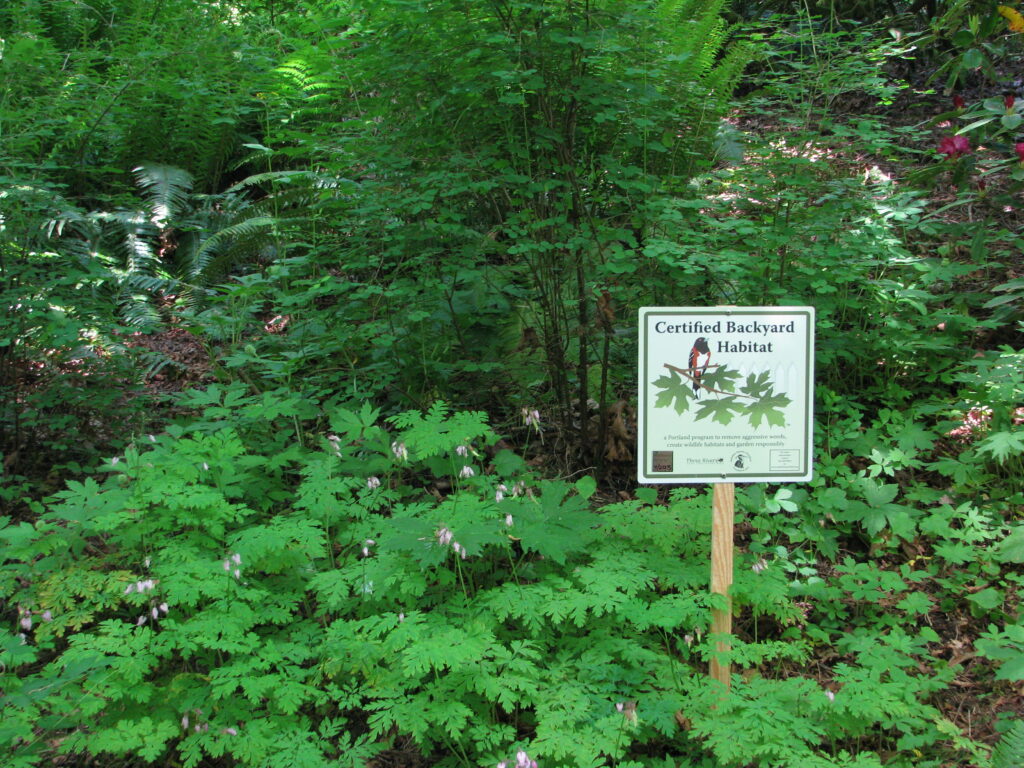
Summary
The Backyard Habitat Certification Program (BHCP) is a microhabitat program jointly managed by Columbia Land Trust and Portland Audubon*. This program, which currently includes over 10,000 backyard habitats, aims to restore ecosystem function via private sites throughout the Portland-Vancouver metro area of Oregon and Washington states.
This case study explores how BHCP is working to create a more inclusive program and diversify participation, thereby expanding its ecological and social impact and benefits. To increase access for people who do not own their own backyards, for example, BHCP now includes over 400 community sites such as churchyards and apartment-complex gardens. Another strategy has been to partner with mission- and culturally-specific community organizations in the area. Microhabitat programs that are looking to be more inclusive and diverse may learn from some takeaways that BHCP’s experience reveals about forging relationships with community organizations:
- Look beyond a one-size-fits-all approach when engaging with partners
- Meet the community where it is with regard to interest in the environment
- Understand community concerns and fears
- Hire and deploy native language speakers
- Build multi-person relationships
- Reinforce the partner organization’s capacity and funding
- Show up to learn
An introduction to the Backyard Habitat Certification Program
The Backyard Habitat Certification Program (BHCP) is an extraordinarily successful microhabitat program based in the Portland-Vancouver metro area, spanning the states of Oregon and Washington. It currently includes over 10,000 backyard habitats and growing, with technicians conducting some 1,400 site visits a year.
The program focuses on private sites smaller than one acre, and community sites of any size, throughout much of urban and suburban Clackamas, Clark, Multnomah and Washington counties. It is supported by over 23 funding relationships, primarily municipal and water conservation districts’ quality and flood-mitigation agencies that receive federal funding for water-quality initiatives.
BHCP finds its roots in the work of what was originally the Three Rivers Land Conservancy, which aimed to conserve private natural land in the watershed areas of the Clackamas, Tualatin and lower Willamette Rivers in Portland. Facing pressure on conservation land from invasive ivy and Himalayan blackberry, the Three Rivers Land Conservancy and West Willamette Restoration Partners created and launched a program to encourage better stewardship and ecological practices among abutting property owners. This evolved into the Backyard Habitat Certification Program, now managed jointly by the Columbia Land Trust and Portland Audubon. Says Susie Peterson, Columbia Land Trust’s BHCP program manager (a responsibility she shares with a counterpart at Portland Audubon), “Both organizations see the program as very important ecologically for creating wildlife corridors through urban and suburban areas, as well as for engaging the public in conservation efforts.”
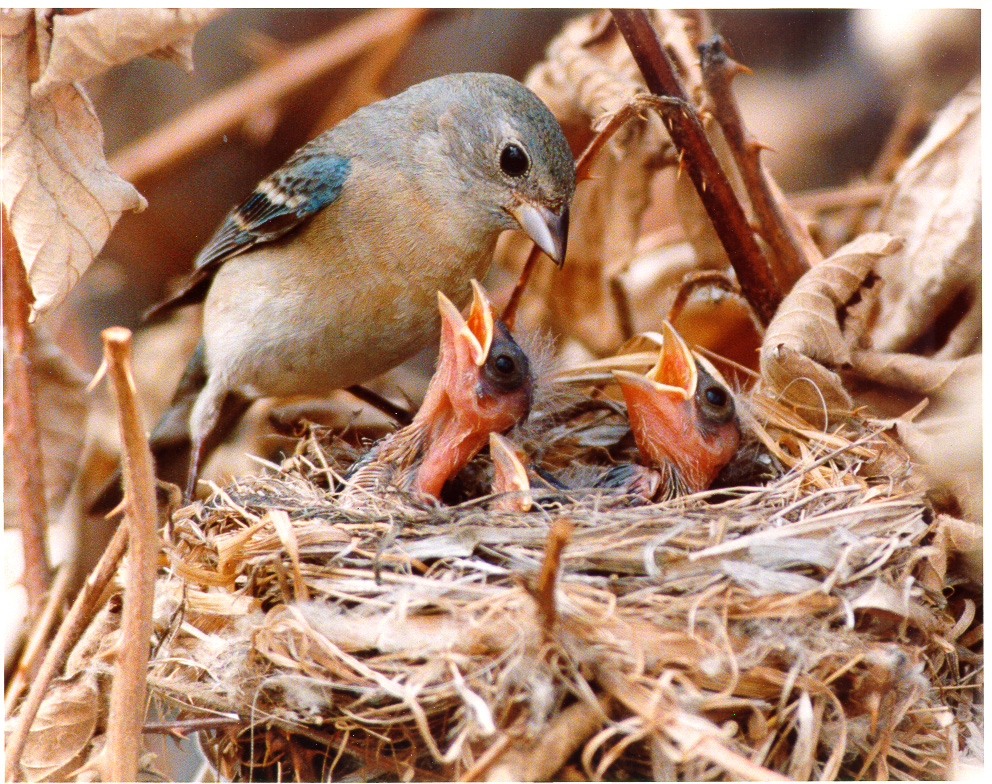
Demographic Challenges In Program Participation
Located 60 miles east of the Pacific Ocean, the Portland-Vancouver metro area lies at the confluence of the Columbia and Wilamette Rivers. Portland, specifically, is the most populous city in the state of Oregon and about half the population of the entire state resides within the Portland metropolitan area. The population of the city is predominantly White, with the next most populous groups being Hispanic and Latino (of any race), Asian and Black/African American. Since the enactment of the Urban Growth Boundary in 1970 to protect surrounding natural spaces and farmland, the city’s population has expanded 60 percent, while the land area has grown by 14 percent. The city, like many other popular urban magnets in the country today, faces skyrocketing rents and housing prices, low stock of affordable housing, and displacement of low income city dwellers, often people of color, ever further away from the city center. Portland grapples with how to create a more livable, healthy and inclusive city.
Given the nature of BHCP, which requires design, modification and planting of yards, along with ongoing maintenance to achieve tiered levels of certification, participants in this backyard habitat program have tended to be homeowners largely of single family homes. These homeowners have historically been mostly affluent, middle-aged to elderly, and Caucasian, located as they are within the expensive urban growth boundary. About nine years ago, BHCP embarked on a variety of efforts to reach a more demographically diverse population and spread the environmental benefits of program participation more widely. Village and Wilderness interviewed Peterson about BHCP’s work to reach beyond the traditional demographics of the program. We believe that participant diversification is a common concern and goal for many backyard habitat programs and that BHCP would have valuable lessons to share.
Two strategies that Peterson shared were the expansion of the program to community sites, and partnerships with community-based organizations. We took a deep dive into the topic of partnerships, but first, a quick look at community sites.
Diversifying Participation through Community Sites
BHCP defines community sites as shared sites, where multiple residents can participate. Unlike individual backyard habitats, community sites can be over an acre in size. Examples include community gardens, churchyards, schoolyards, apartment complexes and other gathering places. Says Peterson, “We recognize that one of the primary barriers in our program is that you have to be privileged enough to own a home and therefore have a yard to garden. This is a big reason why we have a focus on community sites—so that folks who do not have their own yard to garden can still have access to native plants, get their hands in the soil, and reap the health and ecological benefits of gardening.”
BHCP engages with over 400 community sites throughout the program area. Community sites often have committees or groups of people working on building habitat together, which has the additional benefit of building a sense of place and community through their habitat projects.
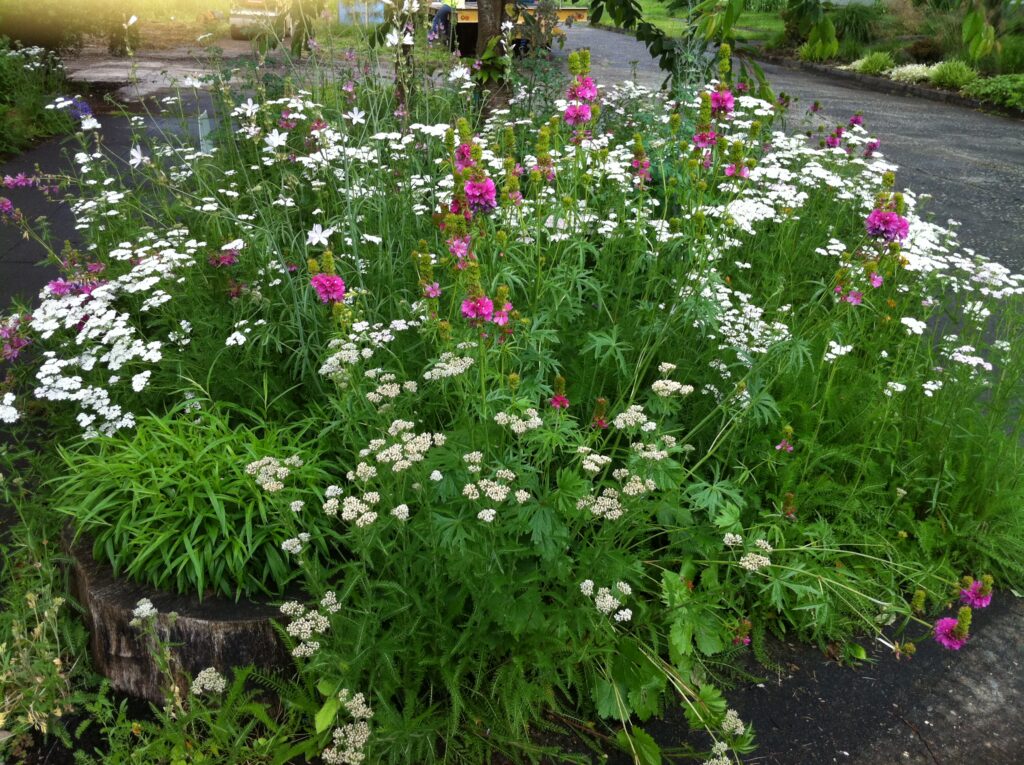
Community Partnerships: Myriad Models Driven by Community Need and Priorities
A second strategy that BHCP has found effective for diversifying access and participation has been forging partnerships with community-based organizations, both mission-specific organizations and culturally-specific organizations. We look at a few different partnerships, each demonstrating a different approach, but sharing an underlying theme.
BHCP’s experience with community partnerships began with the Asian Pacific American Network of Oregon (APANO), a relationship that grew out of connections formed between staff at diversity, equity and inclusion trainings. To launch their joint efforts, the two organizations first hosted a series of community conversations to learn about the priorities of the community. This led to projects such as planting native plants at APANO’s community center and at a nearby community school. It also set a precedent for taking steps early on to truly understand the community’s and partner’s needs and priorities.
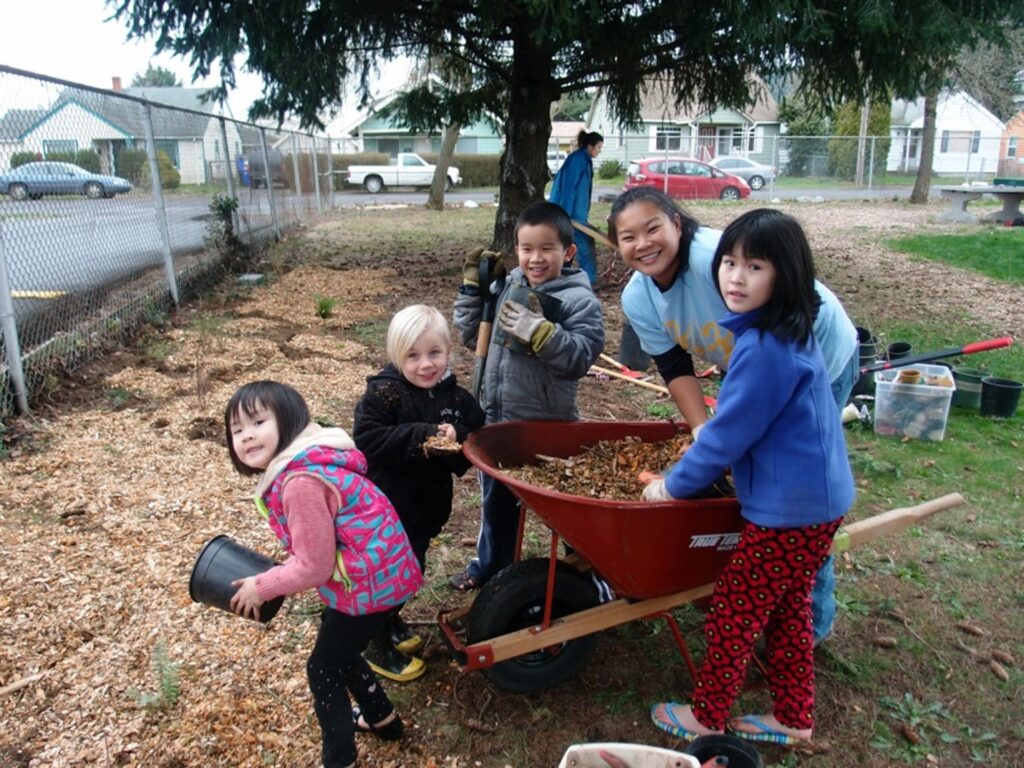
Another partnership that Peterson highlighted is with Verde, an organization that works with communities of color in the Portland area. Highly respected for its community-based environmental work, Verde’s efforts include training people in restoration work and installing rain gardens, a program initiated in 2013. One staff member and passionate community educator, Nestor Campos, who is particularly involved in the rain garden program, reached out to BHCP to partner on enhancing the existing rain garden program with a backyard habitat program. His idea was to surround rain gardens with native plants to boost effectiveness and ecological impact. BHCP has since trained two Verde staff, including Campos, to become backyard habitat technicians, so that they can provide integrated site visits to interested households. Campos and his colleague conduct the initial site visits, educate rain garden participants about native plants, gauge their interest in particular species, and eventually provide plants for a “planting event,” at which many people gather to help install the gardens. BHCP provides on-the-ground support for planning and planting. Along the way, the technicians engage the property stewards in multiple conversations about yard management and maintenance.
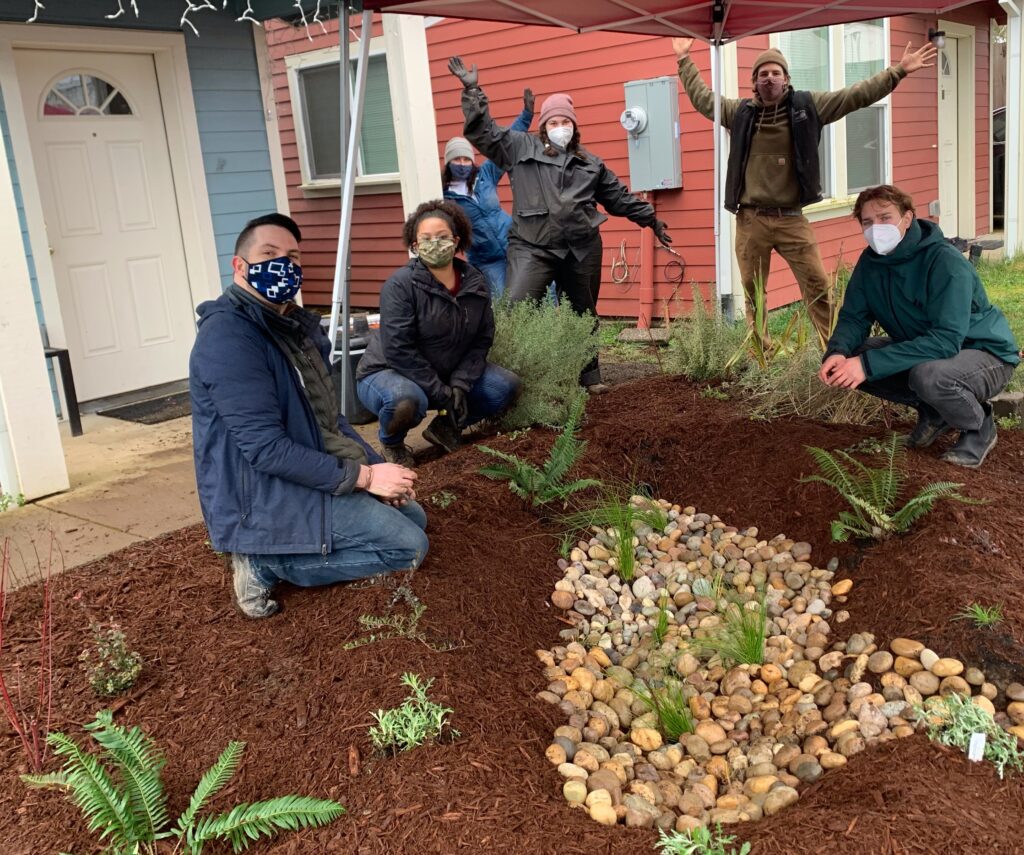
BHCP has hired a community coordinator to support this and other partnerships. The community coordinator attends all the planting events, and conducts other outreach and capacity-building, such as recruiting interns through a local collaborative called Connecting Canopies to help with installation. The planting event becomes a community affair and bolsters the participating families, who feel recognized and see that people in the community care about their initiative.
While these households also participate in the yard certification and signage program and receive the same support and resources as all other BHCP backyards, Peterson stresses that this is not about getting more people to sign up for the program; it is, instead, in her words, for “community engagement and spreading the benefits around.” She notes that many Verde participants live extremely full lives, often working multiple jobs to support and raise their families; they may not be able to fully participate in a yard-sign program or progress through the certification levels. They are nevertheless motivated by the ecological and economic benefits of participating. Together, BHCP and Verde are thinking through how to keep these households supported and engaged for the longer term. They are also exploring ways in which to apply jointly for grants to cover both organizations’ costs.
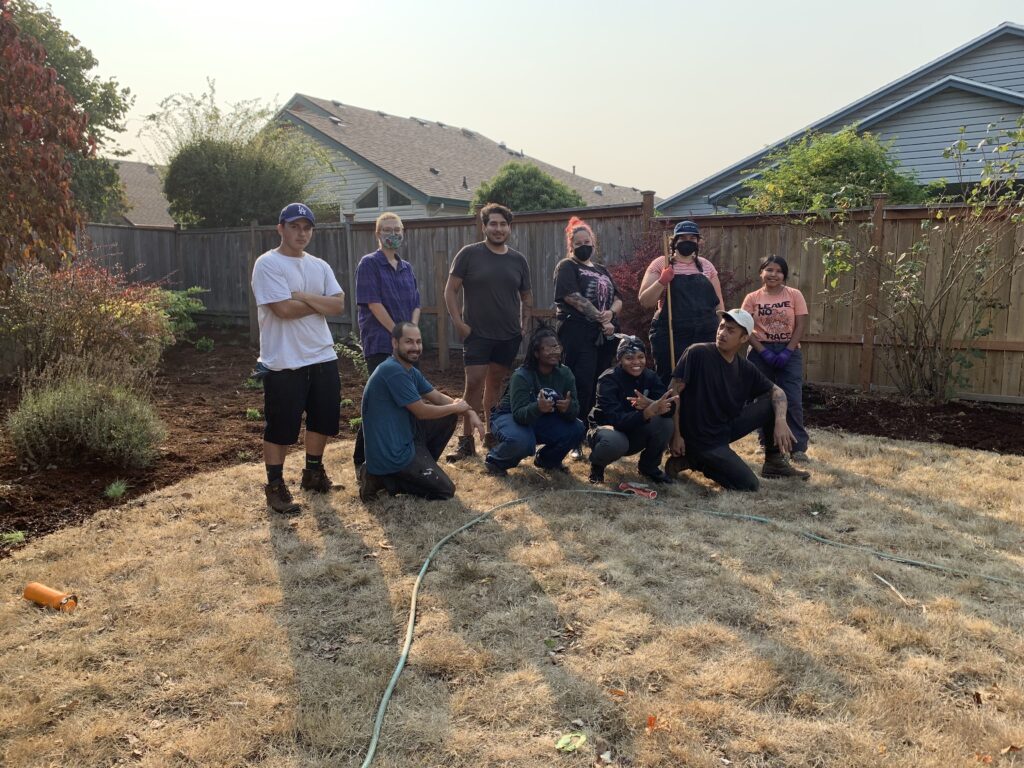
A third example that is illustrative is BHCP’s partnership with Centro Cultural of Washington County. Based in the city of Cornelius and located an hour’s drive from Portland, this tie-up further expands BHCP’s service area. Centro is the oldest culturally-specific Latino organization in Oregon, and undertakes a number of community efforts from providing housing and food, to English language training for job seekers. The organization also has three environmental programs of its own, one to engage the elderly, one to engage youth and one organized around recycling. First introduced to Centro by county officials when exploring an expansion into Washington County, BHCP has now embarked on a multi-year, multi-pronged partnership with Centro to more actively engage a wider segment of Centro’s membership.
Peterson highlighted three main ways in which they are partnering:
- At the outset, they engaged members in creating a vision for the grounds of the organization’s campus, which is located alongside a busy street. Together, they developed and implemented a landscaping plan to convert an area of the grounds to native plants. The goal of the design was to reduce noise and pollution, while creating a beautiful and ecologically-minded space for staff and community members.
- BHCP and Centro are also building community-science capacity among the younger members of the community in areas of pressing need. In collaboration with the Tualatin Soil and Water Conservation District, Centro and BHCP have developed a training program for high schoolers to learn about the Emerald Ash Borer and conduct site visits to collect data and monitor the health of trees. Says Peterson, “This is a really cool thing that we didn’t anticipate at the beginning of our partnership. It emerged as a need because the first Emerald Ash Borer was sighted very close to Centro’s campus.” She continues, “We’ve had a lot of conversations around the fact that the communities most impacted by Ash Borer are often frontline communities such as the one in which Centro operates. We believe it is really important to empower impacted communities and a group like Centro to be able to tackle such issues.”
- BHCP and Centro are also partway through an effort to secure a shared technician position. This new staff person, situated within Centro, will be a native Spanish speaker who connects deeply with the community and conducts outreach and site visits throughout the area on behalf of both organizations.
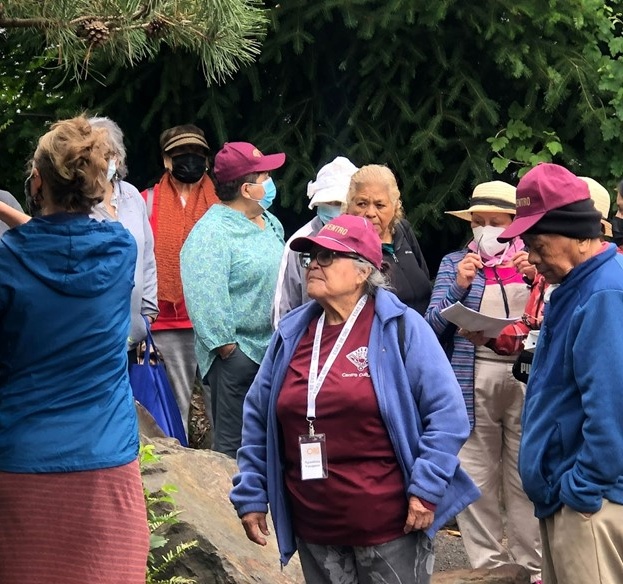
Peterson also noted budding partnerships with other organizations such as Connecting Canopies (mentioned earlier), a collection of local groups that collaborate to create opportunities for professionals of color to enter the green workforce. Growing Gardens is another organization that has a number of initiatives to engage and serve communities of color. They install edible gardens and vegetable beds in yards and also work with incarcerated adults and youth to impart skills such as growing vegetables and, more recently, cultivating native plants. BHCP’s involvement with these organizations is at an early stage and we hope to learn more as these partnerships develop.
Key Takeaways and Reflections on Impact
Surveying the breadth of community touch-points, we asked Peterson to reflect on some takeaways that might help other organizations looking to diversify their community impact through partnerships. Here’s what she had to share:
1. Look beyond a one-size-fits-all approach:
BHCP has found success in its partnerships by being driven by the needs of its partners. As evidenced by the different approaches taken and opportunities revealed by each of its partners, says Peterson, “A cookie-cutter approach would not work for building a true collaboration. You really have to be open to where the needs and priorities of the community and partner organization lie. With every collaboration, we just let them guide. We ask: ‘What are the needs of their community?’, ‘How can we support?’, ‘What does it look like in terms of shared priorities and shared goals, and how can we really lean into those?’”
2. Meet the community where it is at:
Organizations should find ways to engage communities in ways that matter to them, often at a practical level. Says Peterson, “We must look for ways to engage people in our work through projects that reach them where they are at and make them feel connected to the cause. That said, clean air, clean soil, these are things that everyone cares about and can activate around.”
3. Understand community concerns and fears:
Learn about the community, understand their perspective. Something that Peterson noted was to be mindful of community concerns that greening efforts will lead to gentrification, i.e. local populations being priced out of their neighborhoods.
4. Hire and deploy native language speakers:
BHCP is increasingly prioritizing the hiring of native language speakers for community-facing positions such as program support and technicians. Peterson emphasizes that having a surface knowledge of the relevant language does not suffice for the purpose of deep engagement. “All the jargon we use related to rain gardens, native plants and naturescaping does not easily translate. It is important to have native language speakers who have a really deep level of knowledge and experience with the language and can both translate concepts and inspire,” she says. The advantage of working with culturally-specific organizations, she notes, is that they are staffed by native language speakers who can take the message to communities in more impactful and relatable ways.
4. Build a multi-person relationship:
Peterson underlines the importance of relying on more than just one counterpart from each organization to maintain contact. In fact, she recommends having two or three people within each organization responsible for maintaining the relationship. She lays out three reasons for her recommendation: (1) It circumvents silos. She says, “Having just a single counterpart siloes the work in a way that doesn’t make it as authentic for an organization. When you have more counterparts, the relationship does not get siloed.”; (2) it protects precious organizational relationships from the vagaries of staff turnover; and finally, (3) it leads to more robust and vetted efforts and outcomes: “It’s just more minds and more experience coming to the table to have these conversations and think-through projects,” she observes.
5. Reinforce the partners’ orgainzational capacity and funding:
Backyard programs should keep in mind that community organizations almost always have missions that prioritize urgent community needs like housing and food security. They are also constantly being asked by different entities to collaborate and take on more work. Organizations like BHCP should respect these priorities and demands, and strike a balance between supporting the shared program, while not “taking over.” Centro Cultural, for example, is passionate about the BHCP projects, but has extremely limited staff capacity. BHCP thus takes care of time-consuming tasks such as coordinating, scheduling and communicating meetings, while still taking a back seat when it comes to setting priorities and making decisions that affect the community.
Community-based organizations also face funding constraints and must prioritize resource allocation accordingly. Says Peterson, “The only way they are going to be able to engage with programs like ours is if they receive additional funding for their staff to work on these projects. It is important to recognize that upfront and clarify from the beginning, ‘Hey if we partner on something, we’re going to be actively involved in trying to find a grant to cover both our teams for the collaborative work.’”
6. Show up to learn:
Prioritize and support attendance at culturally-specific events regularly. Peterson explained that over a 2-year period, BHCP attended monthly community events as a way to meet new partners and start understanding the needs and vibe of the communities. Such events included a night market hosted by a local Asian and Pacific Islander organization; the celebration of a new park that had been hard won by a community group; an Indigenous celebration and market hosted at a local church; and a festival hosted at a trailer park. These were not private events or those intended for the respective communities alone, but events that were publicized as being open to the general public. Says Peterson, “We worked the time for that into one of our grants, explaining that attending the events was a way to learn more about the goals and priorities of the communities in our region, and to more authentically build relationships by taking the time to show-up in person. We ended up learning so much and meeting lots of wonderful people that are still in our network today. This was a really amazing step in our learning journey, and had the added benefit of being a really fun way to spend time with our teammates outside of the email-and-meeting grind.” About attendance at these events, Peterson goes on to say: “Soak it all in and learn as much as you can without any specific motive other than that. If you happen to meet someone and it leads to something, awesome! But in the meantime you know a little more than you did before and had fun learning!”
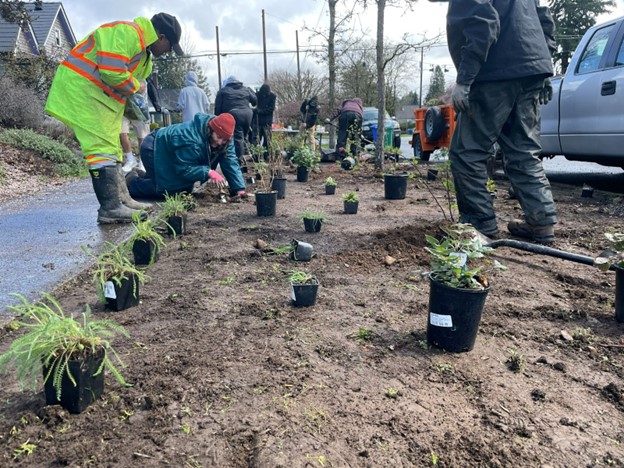
By building these partnerships, organizations such as BHCP are contributing to important conversations around how land trust properties and environmental programming become more accessible to diverse communities. Peterson notes, “We recognize that land trusts are amassing large tracts of property and intrinsic wealth. We need to ask how we can share this wealth and provide benefits to the communities who live in the areas in which we work and conserve land.”
As for impact on organizational membership, Peterson notes that BHCP is not tracking whether such engagement efforts lead to increased membership or donations. When it comes to impact through such engagement, the appropriate yardstick she feels is not metrics on how it benefits BHCP, but how it bolsters the community partner and thus also the ecology of the planet long-term. Underscores Peterson, “The impetus really has to come from the heart of the organization.”
When asked what excites her as she looks to the future of these collaborations, Peterson says:
“There’s a growing awareness around the harm that humans have caused to the earth. But there is also a growing sense of empowerment in realizing there are things we can do. We are tapping into that and trying to do it in ways where we are not just reaching the same people—culturally and demographically—over and over again, but instead in ways where everyone can relate and get involved. That is what excites me, although we have a long way to go and a lot to learn.”
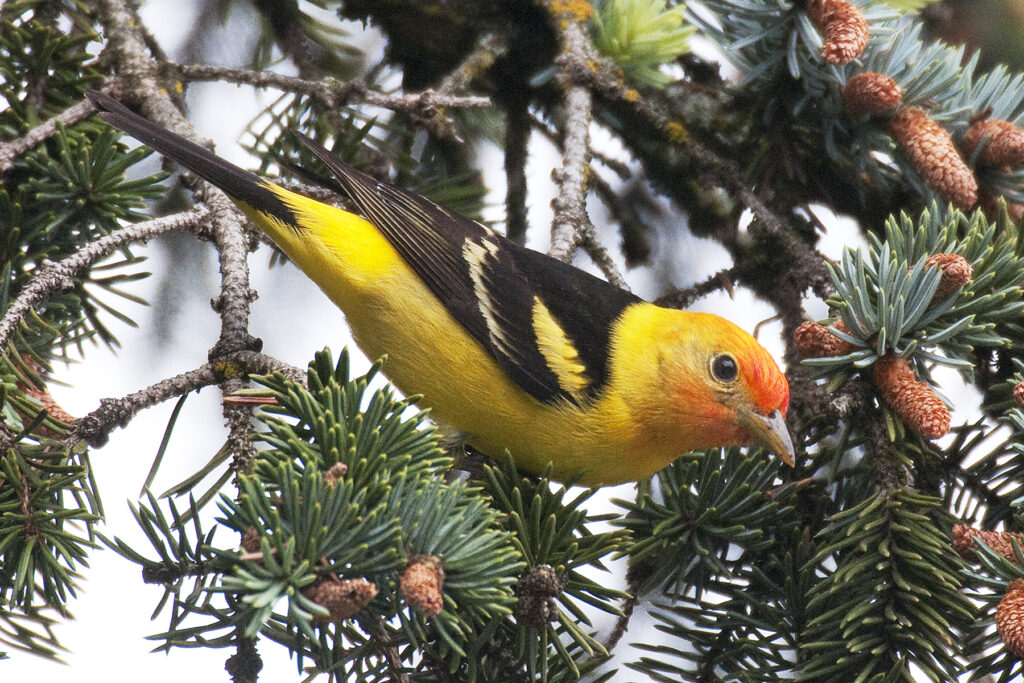
* Please note that since the publishing of this case study, Portland Audubon has been renamed Bird Alliance of Oregon.
Village and Wilderness amplifies the work of community-based innovators by supporting efforts to discover, prove and share replicable climate adaption strategies. Our flagship project is the Microhabitat Program Incubator.
This case study is part of a series of written resource materials that Village and Wilderness is developing to share lessons and best-practices across existing and emerging microhabitat programs.
What is a Microhabitat Program?
Community-based programs designed to convert small patches of land into ecologically useful habitat are emerging everywhere. From rewilding private land, to establishing urban shade gardens, bioswales and pollinator-friendly roadside verges and farmland margins—restoring ecosystem function in the fragmented landscape is the common theme.
While “backyard habitat programs” is a term that has been commonly used to describe many of these efforts, we propose more encompassing terms—such as microhabitat programs. We believe that these programs are part of a broader movement comprising the universe of community-based and individual efforts and to restore ecosystem function and ecological productivity to the fragmented landscape.

